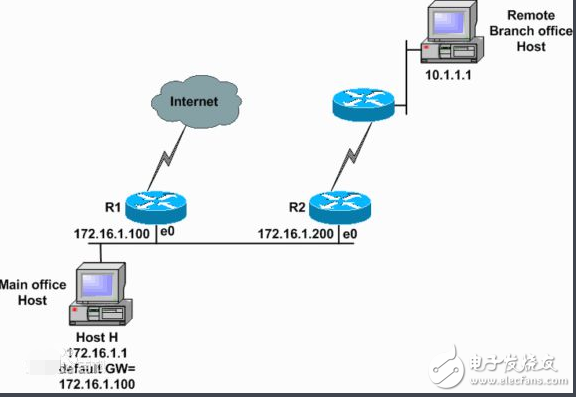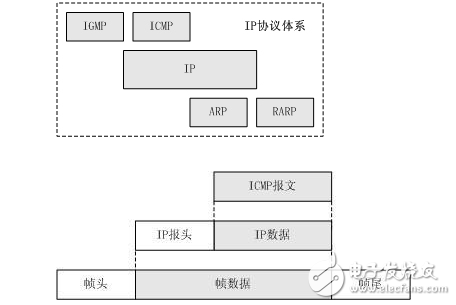ICMP is the Internet Control Message Protocol (Internet Control Message Protocol) protocol. It is a sub-protocol of the TCP/IP protocol suite for passing control messages between IP hosts and routers. The control message refers to the network itself, such as the network is unreachable, the host is reachable, and the route is available. Although these control messages do not transmit user data, they play an important role in the transmission of user data.
definitionThe ICMP protocol is a connectionless protocol for transmitting error reporting control information. It is a very important protocol and it is extremely important for network security.
It is a sub-protocol of the TCP/IP protocol family and belongs to the network layer protocol. It is mainly used to transfer control information between the host and the router, including reporting errors, exchange limited control, and status information. ICMP messages are automatically sent when IP data cannot be accessed and the IP router cannot forward packets at the current transmission rate. The value of the ICMP packet in the header protocol type field (Protocol 8bit) of the IP frame structure is 1.
As shown in the following figure, the ICMP packet has an 8-byte long header, where the first 4 bytes are in a fixed format, including an 8-bit type field, an 8-bit code field, and a 16-bit checksum; the last 4 bytes. Different values ​​are taken depending on the type of ICMP packet.

ICMP provides consistent and error-prone information. The sent error message is returned to the device that sent the original data, because only the sending device is the logical recipient of the error message. The sending device can then determine the type of error that occurred based on the ICMP message and determine how to better retransmit the failed packet. But the only function of ICMP is to report the problem instead of correcting the error, and the task of correcting the error is done by the sender.
We often use the ICMP protocol in the network. For example, we often use the Ping command to check the network (both in Linux and Windows). This "Ping" process is actually the process of working with the ICMP protocol. There are other network commands such as tracert Tracert commands that are also based on the ICMP protocol.

The icmp protocol is a sub-protocol of the IP layer and is a protocol between the IP layer and the TCP layer. It is generally considered to belong to the IP layer protocol. The IP protocol uses it to exchange error messages and other network conditions with other hosts or routers. The ICMP packet carries the control information and the failure recovery information. It is mainly used to control the error that the router host sends error packets to other routers or hosts.
ICMP features
ICMP itself is a protocol at the network layer;
The ICMP error report uses the router-source host mode. When the router finds an error in the datagram transmission, the router only reports the cause of the error to the source host.
ICMP does not guarantee that all IP datagrams can be transmitted to the destination host;
ICMP can't correct the error, it just reports the error. Error handling needs to be done by high-level protocols.
It is a sub-protocol of the TCP/IP protocol suite for passing control messages between IP hosts and routers. The control message refers to the network itself, such as the network is unreachable, the host is reachable, and the route is available. Although these control messages do not transmit user data, they play an important role in the transmission of user data. The role and characteristics of ICMP ICMP features: ICMP itself is a protocol at the network layer; ICMP error reporting uses the router-source host mode, the router only reports the cause of the error to the source host when it finds an error in the datagram transmission; ICMP does not guarantee All IP datagrams can be transmitted to the destination host; ICMP cannot correct the error, it just reports the error. Error handling needs to be done by high-level protocols. ICMP message type ICMP error control ICMP error report message: Destination station unreachable: Source station suppression timeout parameter problem Change route destination station Unreachable network unreachable (host unreachable) Host unreachable Protocol unreachable (protocol unreachable) ) port unreachable source route failed (source route failed) destination network agnostic (unknown desTInaTIon network) destination host agnostic (unknown desTInaTIon host)
1.0mm (.039″) Pitch Pin Headers
Overview
Antenk offers a variety of high quality and competitively priced 1.0mm pitch single, dual, three, quad row pin (male) headers used in many board-to-board PCB connections, fitting small-sized, densely-packed devices.
This low-profile component is made from high-temperature thermoplastic and is offered with several means of connections and mounting styles such as through-hole (THM) or surface mount (SMT) and can be in vertical (straight), elevated or at a right angle configuration/orientation dissipating current of about 1.0 A or less.
The pin (male) header is generally mated with receptacle or stackable header connectors (female sockets). This types of pin headers are suitable for PCB board to board connection or for signal transmission application.
Applications of 1.0mm Pitch Pin Headers
Its small size is most suitable for PCB connections of small equipment and devices such as WiFi equipment, gaming consoles, measurement instruments, and other equipment in need of a special interface to become interconnected
Mount Type: Through-hole vs Surface Mount
At one side of this pin header is a series of pins which can either be mounted and soldered directly onto the surface of the PCB (SMT) or placed into drilled holes on the PCB (THM).
Through-Hole (Poke-In)
Best used for high-reliability products that require stronger connections between layers.
Aerospace and military products are most likely to require this type of mounting as these products experience extreme accelerations, collisions, or high temperatures.
Useful in test and prototyping applications that sometimes require manual adjustments and replacements.
1.0mm vertical single row header, 1.0mm vertical dual row header, 1.0mm Elevated single row pin header, 1.0mm Elevated dual row pin Header, 1.0mm Right-angle single row header and 1.0mm Right-angle dual row header are some examples of Antenk products with through-hole mount type.
Surface-Mount
The most common electronic hardware requirements are SMT.
Essential in PCB design and manufacturing, having improved the quality and performance of PCBs overall.
Cost of processing and handling is reduced.
SMT components can be mounted on both side of the board.
Ability to fit a high number of small components on a PCB has allowed for much denser, higher performing, and smaller PCBs.
1.0mm Right-angle Dual Row pin header, 1.0mm SMT Single row pin header, 1.0mm SMT Dual row pin header and 1.0mm Elevated Dual Row Pin Header are Antenk`s SMT pin headers.
Soldering Temperature for 1.0mm Pitch Pin Headers
Soldering SMT pin header can be done at a maximum peak temperature of 260°C for maximum 60 seconds.
Pin-Type: Vertical (Straight) and Right-Angle
1.0mm pitch headers may be further classified into pin orientation as well, such as vertical or straight male header or right-angle male header.
Vertical or Straight Pin (Male) Header Orientation
One side of the series of pins is connected to PCB board in which the pins can be at a right-angle to the PCB surface (usually called "straight" or [vertical") or.
Right-Angle Pin (Male) Header Orientation
Parallel to the board's surface (referred to as "right-angle" pins).
Each of these pin-types have different applications that fit with their specific configuration.
PCB Connector Stacking
Elevated Pin Header Orientation
Elevated pins aka Stacked Pins or Mezzanine are simply stacked pin headers providing an exact distance requirement between PCBs that optimizes electrical reliability and performance between PCB boards.
Profile Above PCB
This type of configuration is the most common way of connecting board-to-board by a connector. First, the stacking height is calculated from one board to another and measured from the printed circuit board face to its highest insulator point above the PCB.
Single, Dual or Multiple Number of Rows
For a 1.0mm straight or vertical male pin header, the standard number of rows that Antenk offers ranges from 1 to 2 rows. However, customization can be available if 3 ,4 or n number of rows is needed by the customer. Also, the number of contacts for the single row is about 2-50 pins while for dual row, the number contacts may vary from 4-100 pins.
Pin Material
The pins of the connector have been designed with copper alloy. With customer`s demand the pins can be made gold plated.
Breakaway design
The pin headers are also equipped with a breakaway design making them fully compatible with their female receptacles.
Custom 1.0mm Pitch Pin Headers
Customizable 1.0 mm pitch pin headers are also available, making your manufacturing process way faster as the pins are already inserted in the headers, insulator height is made at the right size and the accurate pin length you require is followed.
Parts are made using semi-automated manufacturing processes that ensure both precision and delicacy in handling the headers before packaging on tape and reel.
The tape and reel carrier strip ensures that the headers are packaged within accurately sized cavities for its height, width and depth, securing the headers from the environment and maintaining consistent position during transportation.
Antenk also offer a range of custom Tape and reel carrier strip packaging cavities.
Male Header Pins,1.0Mm Male Header,1.0Mm Pin Header,1.0Mm Male Header Pins, 1.0mm THM Male Header, 1.0mm SMT Male Header
ShenZhen Antenk Electronics Co,Ltd , https://www.antenk.com